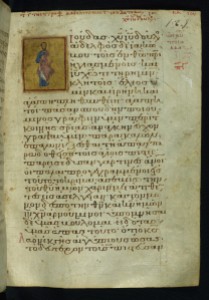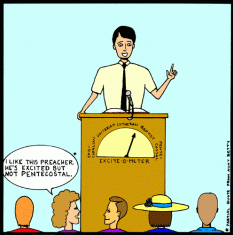 In a phone conversation with a friend today, we were discussing grammatical-historical methods of interpretation and how the NT writers simply did not appear to observe this modern system for interpretation (which claims, in my opinion, an overly “scientific” approach to Scripture that fails to grapple with the full complexities of language, inspiration, and later interpretations, but all that aside [if you want a glimpse at my own brief forays in my quest for better methods read HERE, HERE, and HERE]).
In a phone conversation with a friend today, we were discussing grammatical-historical methods of interpretation and how the NT writers simply did not appear to observe this modern system for interpretation (which claims, in my opinion, an overly “scientific” approach to Scripture that fails to grapple with the full complexities of language, inspiration, and later interpretations, but all that aside [if you want a glimpse at my own brief forays in my quest for better methods read HERE, HERE, and HERE]).
He mentioned Jude 5 which reads:
“Now I desire to remind you (even though you have been fully informed of these facts once for all) that Jesus, having saved the people out of the land of Egypt, later destroyed those who did not believe.” (NET -bolding added)
Talk about a strange reading of the Exodus account! (Origen would be proud 😉 ). So I went to look it up in my NA27 and discovered an overwhelming manuscript support for the reading “Jesus” (A B 33. 81. 322. 323. 424c. 665. 1241. 1739. 1881. 2298. 2344. Vulgate, Coptic (Bohairic, Sahidic), Ethiopic. Origen, Cyril, Jerome, Bede; “the Jesus” 88. 915) over “[the] Lord” (K Maj.).* Not only is the textual support overwhelmingly in support of such a reading, but the probability is overwhelmingly in favor of an original “Jesus” being changed to “Lord” (rather than vice versa). Who would think of changing “Lord” to “Jesus”? It would seem to make things more defensible (for reading the OT as it was intended by its original human author) with reading “Lord” in light of the OT, but “Jesus” offers a sharply Christological reading of the Hebrew scriptures (which fits Jude’s overall agenda). Even Bruce Metzger’s A Textual Commentary on the Greek New Testament (ABS, 1994, p.657) has an extended bracketed discussion of this issue suggesting that the reading “Lord” really does not appear original in any sense. And yet, the UBS4 and NA27 texts maintained κύριος (“Lord”) in the main text. I don’t have access to NA28, but I would be curious to know if they’ve continued this strange tradition.
Incidentally, some English translations actually have “Jesus” (ESV, NET, NLT; and the Latin Vulgate)** in their primary text despite the preference for “Lord” in these two critical Greek texts (which are knowingly nearly identical) which typically form the basis for English translations (not that there aren’t plenty of times where the translators chose a different variant, but this one is rather fascinating).***
To me, the most significant (and fascinating) thing I was reminded of in my searching through the evidence and the translations, was that it appears issues of congruity for English readers often drives translations against where the textual evidence may actually point (one of the reasons I quite like the NET for boldly trying to follow the original text closely…at least at times).
So what are your thoughts on a variant like this and the need to translate what is considered the “best” (or most appropriate?) text?
_________________
* To be fair there are a number of other lesser attested readings which are not supported well by either internal or external criteria.
** The ESV footnotes “some manuscripts” having “Lord”; the NLT says: “As in the best manuscripts; various other manuscripts read the Lord, or God, or Christ; one reads God Christ.” The NET reads:
“tc ‡ The reading ᾿Ιησοῦς (Iesous, “Jesus”) is deemed too hard by several scholars, since it involves the notion of Jesus acting in the early history of the nation Israel. However, not only does this reading enjoy the strongest support from a variety of early witnesses (e.g., A B 33 81 1241 1739 1881 2344 pc vg co Or1739mg), but the plethora of variants demonstrate that scribes were uncomfortable with it, for they seemed to exchange κύριος (kurios, “Lord”) or θεός (theos, “God”) for ᾿Ιησοῦς (though Ì72 has the intriguing reading θεὸς Χριστός [theos Cristos, “God Christ”] for ᾿Ιησοῦς). In addition to the evidence supplied in NA27 for this reading, note also {88 322 323 424c 665 915 2298 eth Cyr Hier Bede}. As difficult as the reading ᾿Ιησοῦς is, in light of v. 4 and in light of the progress of revelation (Jude being one of the last books in the NT to be composed), it is wholly appropriate.”
*** Those translations offering “Lord” are KJV, NAB, NASB, NIV(1984, 2010), NJB, NKJV, NRSV, TNIV. The NAB footnotes that “manuscripts vary”; the NASB only mentions “two early mss” mentioning “Jesus”; the NIV tradition has “some early manuscripts” reading “Jesus”; and the NRSV has “Other ancient authorities read though you were once for all fully informed, that Jesus (or Joshua) who saved.”




 The History Channel is releasing
The History Channel is releasing



Jesus Led Israel Out of Egypt?
He mentioned Jude 5 which reads:
Talk about a strange reading of the Exodus account! (Origen would be proud 😉 ). So I went to look it up in my NA27 and discovered an overwhelming manuscript support for the reading “Jesus” (A B 33. 81. 322. 323. 424c. 665. 1241. 1739. 1881. 2298. 2344. Vulgate, Coptic (Bohairic, Sahidic), Ethiopic. Origen, Cyril, Jerome, Bede; “the Jesus” 88. 915) over “[the] Lord” (K Maj.).* Not only is the textual support overwhelmingly in support of such a reading, but the probability is overwhelmingly in favor of an original “Jesus” being changed to “Lord” (rather than vice versa). Who would think of changing “Lord” to “Jesus”? It would seem to make things more defensible (for reading the OT as it was intended by its original human author) with reading “Lord” in light of the OT, but “Jesus” offers a sharply Christological reading of the Hebrew scriptures (which fits Jude’s overall agenda). Even Bruce Metzger’s A Textual Commentary on the Greek New Testament (ABS, 1994, p.657) has an extended bracketed discussion of this issue suggesting that the reading “Lord” really does not appear original in any sense. And yet, the UBS4 and NA27 texts maintained κύριος (“Lord”) in the main text. I don’t have access to NA28, but I would be curious to know if they’ve continued this strange tradition.
Incidentally, some English translations actually have “Jesus” (ESV, NET, NLT; and the Latin Vulgate)** in their primary text despite the preference for “Lord” in these two critical Greek texts (which are knowingly nearly identical) which typically form the basis for English translations (not that there aren’t plenty of times where the translators chose a different variant, but this one is rather fascinating).***
To me, the most significant (and fascinating) thing I was reminded of in my searching through the evidence and the translations, was that it appears issues of congruity for English readers often drives translations against where the textual evidence may actually point (one of the reasons I quite like the NET for boldly trying to follow the original text closely…at least at times).
So what are your thoughts on a variant like this and the need to translate what is considered the “best” (or most appropriate?) text?
_________________
* To be fair there are a number of other lesser attested readings which are not supported well by either internal or external criteria.
** The ESV footnotes “some manuscripts” having “Lord”; the NLT says: “As in the best manuscripts; various other manuscripts read the Lord, or God, or Christ; one reads God Christ.” The NET reads:
*** Those translations offering “Lord” are KJV, NAB, NASB, NIV(1984, 2010), NJB, NKJV, NRSV, TNIV. The NAB footnotes that “manuscripts vary”; the NASB only mentions “two early mss” mentioning “Jesus”; the NIV tradition has “some early manuscripts” reading “Jesus”; and the NRSV has “Other ancient authorities read though you were once for all fully informed, that Jesus (or Joshua) who saved.”